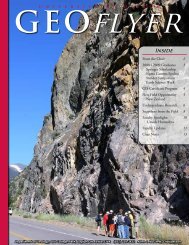Stander Symposium abstract book - University of Dayton
Stander Symposium abstract book - University of Dayton
Stander Symposium abstract book - University of Dayton
Create successful ePaper yourself
Turn your PDF publications into a flip-book with our unique Google optimized e-Paper software.
POSTER SESSION 1<br />
SCHOOL OF ENGINEERING<br />
Appropriate Technology for Extraction <strong>of</strong> Essential Oils from Orange Peels in La Paz,<br />
Bolivia<br />
Presenter(s): Monica A Guisfredi<br />
Advisor(s): Amy R Ciric, Malcolm W Daniels<br />
Chemical and Materials Engineering - Honors Thesis<br />
Located near the rainforest, La Paz, Bolivia, has a large amount <strong>of</strong> waste orange peels currently being left unused that have the potential to become<br />
pr<strong>of</strong>itable since orange oil, an essential oil that retains the distinctive essence <strong>of</strong> the original plant, can be extracted from the peel. Essential<br />
oils, or concentrated extracts that are derived from a plantâs leaves, roots, blossoms, or other organic materials, have become integrated into<br />
society mostly as flavorings and fragrances, but can also be used in other areas such as medicine and aromatherapy. This project investigates past<br />
and current processes <strong>of</strong> essential oil extraction from orange peels, and an appropriate small scale distillation set-up was designed and built that<br />
is technologically feasible and sustainable for La Paz, Bolivia.<br />
Artificial Neural Networks and Their Use in Process Monitoring and Diagnosis <strong>of</strong> an<br />
Industrial Injection Molding Process<br />
Presenter(s): Rebecca L Greider<br />
Advisor(s): Michael J Elsass<br />
Chemical and Materials Engineering - Honors Thesis<br />
This study utilizes a working artificial neural network (ANN) to monitor an industrial injection molding process. This ANN will be able to adapt and<br />
learn using training data obtained from the process. Outputs will be classified as normal or not normal based uponannotations made on the data<br />
by a plant engineer. This network will be able to recognize patterns in the data it analyzes and will also be able to model complex relationships<br />
in the data. The goal is to use the ANN to predict a future unusable part. ANN performance will beevaluated on how far in advance it can reliably<br />
predict an unusable part: several parts in the future versus the next one to be produced.<br />
Carbon Nan<strong>of</strong>luids as New Liquid Coolants<br />
Presenter(s): Lawrence W Funke<br />
Advisor(s): Khalid Lafdi<br />
Chemical and Materials Engineering - Honors Thesis<br />
New technologies require greater cooling capacity than can be supplied by conventional fluids, such as water, ethylene glycol, or oil. The new<br />
nan<strong>of</strong>luids containing nanoparticles (one thousandth the thickness <strong>of</strong> a human hair) can significantly increase the cooling capacity <strong>of</strong> common<br />
fluids. This project aims to explore new fluids with added carbon nanoparticles. Ethylene glycol was used as the base fluid, and carbon nanoparticles<br />
with various crystallinities were added to the fluid. Fluids with different concentrations <strong>of</strong> additives (0 to 1%) were tested using three<br />
different apparatus to determine their cooling capacity under both static (stationary) and dynamic (in motion) conditions. It was found that the<br />
crystallinity and concentration <strong>of</strong> nanoparticles had a major effect. Results suggest that adding low concentrations <strong>of</strong> carbon nanoparticles with<br />
the proper crystallinity could greatly increase the heat transfer coefficient <strong>of</strong> the base fluid.<br />
Controlling the Corrosion <strong>of</strong> Metals with Polyphenolic Proteins<br />
Presenter(s): William F Nelson<br />
Advisor(s): Douglas C Hansen<br />
Chemical and Materials Engineering - Graduate Research<br />
Flash rusting is a corrosion process in which steel rapidly oxidizes upon contact with air at a high relative humidity. The ultimate goal <strong>of</strong> this research<br />
is to develop a bio-inspired flash rust inhibitor that is water-soluble and environmentally friendly. Several proteins and polypeptides from<br />
two classes <strong>of</strong> marine invertebrates have been identified for their potential to inhibit corrosion: the blue mussel Mytilus edulis and the sea squirts<br />
Mogula manhattensis and Styela clava. The most important feature <strong>of</strong> these biomolecules for corrosion prevention applications is the presence<br />
<strong>of</strong> post-translationally modified amino acid L-3, 4 dihydroxyphenylalanine (L-dopa). L-dopa has a well characterized ability to form strong bonds<br />
63

















